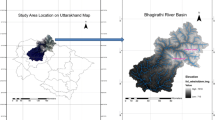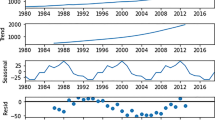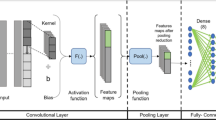Abstract—With the focus on renewable energy resources due to environmental reasons, reliable forecasting of renewable energy has great societal importance. This study focuses on the analysis and forecasting of GHI data at two different locations in India, namely Pokhran and Bitta. Since the GHI time series plots exhibit seasonality and randomness, the time series SARIMA model along with two machine learning models, namely MLP and LSTM, are implemented for daily, weekly and monthly forecasting. The efficacy of these competitive models is assessed using MAPE and RMSE values. We also perform residual analysis as a post processing step of the implemented models. For monthly forecasting, the SARIMA model has the best performance, as it precisely captures monthly seasonality in comparison to the machine learning models. However, for short term daily forecasting, machine learning models provide much better estimates with MLP as the most desirable one. Since the SARIMA model fails to fully capture the high amount of fluctuation (mostly, seasonal fluctuation) in the daily and weekly observations, we additionally implement an ARIMA model with sliding windows to improve modelling efficacy. The present study therefore provides a clear guideline on the selection of forecasting models based on the desired time horizon.










Similar content being viewed by others
DATA AVAILABILITY STATEMENT
The dataset for the present study is publicly available in the National Solar Radiation Database (NSRDB) maintained by the US Department of Energy (https://nsrdb.nrel.gov/). The website was last accessed in July, 2021.
REFERENCES
Government of India. Ministry of Power, Power sector at a glance all India, July 2021. https://powermin.gov.in/en/content/power-sector-glance-all-india.
Lu, T., Sherman, P., Chen, X., Chen, S., Lu, X., and McElroy, M., India’s potential for integrating solar and on-and offshore wind power into its energy system, Nat. Commun., 2020, vol. 11, pp. 1–10.
Voyant, C., Notton, G., Kalogirou, S., and Nivet, M., L., Paoli, C., Motte, F., and Fouilloy, A., Machine learning methods for solar radiation forecasting: A review, Renewable Energy, 2017, vol. 105, pp. 569–582.
Impram, S., Nese, S.V., and Oral, B., Challenges of renewable energy penetration on power system flexibility: A survey, Energy Strategy Rev., 2020, vol. 31, p. 100539.
Gensler, A., Henze, J., Sick, B., and Raabe, N., Deep learning for solar power forecasting an approach using Auto Encoder and LSTM Neural Networks, 2016 IEEE International Conference on Systems, Man, and Cybernetics (SMC), 2016, pp. 002858–002865.
Martın, L., Zarzalejo, L.F., Polo, J., Navarro, A., Marchante, R., and Cony, M., Prediction of global solar irradiance based on time series analysis: Application to solar thermal power plants energy production planning, Sol. Energy, 2010, vol. 84, pp. 1772–1781.
Santhosh, M., Venkaiah, C., and Kumar, V., Current advances and approaches in wind speed and wind power forecasting for improved renewable energy integration: A review, Eng. Rep., 2020, vol. 2, p. e12178.
Reikard, G., Predicting solar radiation at high resolutions: A comparison of time series forecasts, Sol. Energy, 2009, vol. 83, pp. 342–349.
Reikard, G., Haupt, S.E., and Jensen, T., Forecasting ground-level irradiance over short horizons: Time series, meteorological, and time-varying parameter models, Renewable Energy, 2017, vol. 112, pp. 474–485.
Reikard, G. and Hansen, C., Forecasting solar irradiance at short horizons: Frequency and time domain models, Renewable Energy, 2019, vol. 135, pp. 1270–1290.
Yang, D., Jirutitijaroen, P., and Walsh, W.M., Hourly solar irradiance time series forecasting using cloud cover index, Sol. Energy, 2012, vol. 86, pp. 3531–3543.
Sahin, A., Kumbasar, T., Yesil, E., Doýdurka, M.F., and Karasakal, O., An approach to represent time series forecasting via fuzzy numbers, 2014 2nd Int. Conf. on Artificial Intelligence, Modelling and Simulation, 2014, pp. 51–56.
Alsharif, M.H., Younes, M.K., and Kim, J., Time series ARIMA model for prediction of daily and monthly average global solar radiation: The case study of Seoul, South Korea, Symmetry, 2019, vol. 11, p. 240.
Sharadga, H., Hajimirza, S., and Balog, R.S., Time series forecasting of solar power generation for large-scale photovoltaic plants, Renewable Energy, 2020, vol. 150, pp. 797–807.
Shi, J., Lee, W.J., Liu, Y., Yang, Y., and Wang, P., Forecasting power output of photovoltaic systems based on weather classification and Support Vector Machines, IEEE Transactions on Industry Applications, 2012, vol. 48, pp. 1064–1069.
Isaksson, E. and Karpe Conde, M., Solar power forecasting with machine learning techniques, Degree Project in Mathematics, KTH Royal Institute of Technology, Sweden, 2018.
Malakar, S., Goswami, S., Ganguli, B., Chakrabarti, A., Roy, S.S., Boopathi, K., and Rangaraj, A., Designing a long short-term network for short-term forecasting of global horizontal irradiance, SN Appl. Sci., 2021, vol. 3, no. 4, pp. 1–15.
Yadav, A.K. and Chandel, S., Solar energy potential assessment of western Himalayan Indian state of Himachal Pradesh using J48 algorithm of WEKA in ANN based prediction model, Renewable Energy, 2015, vol. 75, pp. 675–693.
Adhikari R., and Agrawal, R.K., An introductory study on time series modelling and forecasting, arXiv:1302.6613, 2013.
Anderson, D.R., Sweeney, D.J., Williams, T.A., Camm, J.D., and Cochran, J.J., Statistics for Business and Economics, Boston, MA: Cengage Learning, 2016.
Nematchoua, M.K., Jose, O., and Afaifia, M., Prediction of daily global solar radiation and air temperature using six machine learning algorithms; a case of 27 European countries, Ecol. Inf., 2022, vol. 69, p. 101643.
ACKNOWLEDGMENTS
The authors acknowledge two anonymous reviewers for their valuable comments and suggestions. We sincerely thank Professor Gordon Reikard (USA Cellular) for his time-to-time advise on time series models. Partial funding was available from DST-SERB’s MATRICS scheme (File No: MTR/2021/000458). The first author acknowledges the research fellowship from UGC, India (Ref. no. 1026/UGC-CSIR-June 2018).
Author information
Authors and Affiliations
Corresponding author
Ethics declarations
The authors declare that they have no conflicts of interest.
About this article
Cite this article
Sarita Sheoran, Singh, R.S., Pasari, S. et al. Forecasting of Solar Irradiances using Time Series and Machine Learning Models: A Case Study from India. Appl. Sol. Energy 58, 137–151 (2022). https://doi.org/10.3103/S0003701X22010170
Received:
Revised:
Accepted:
Published:
Issue Date:
DOI: https://doi.org/10.3103/S0003701X22010170




